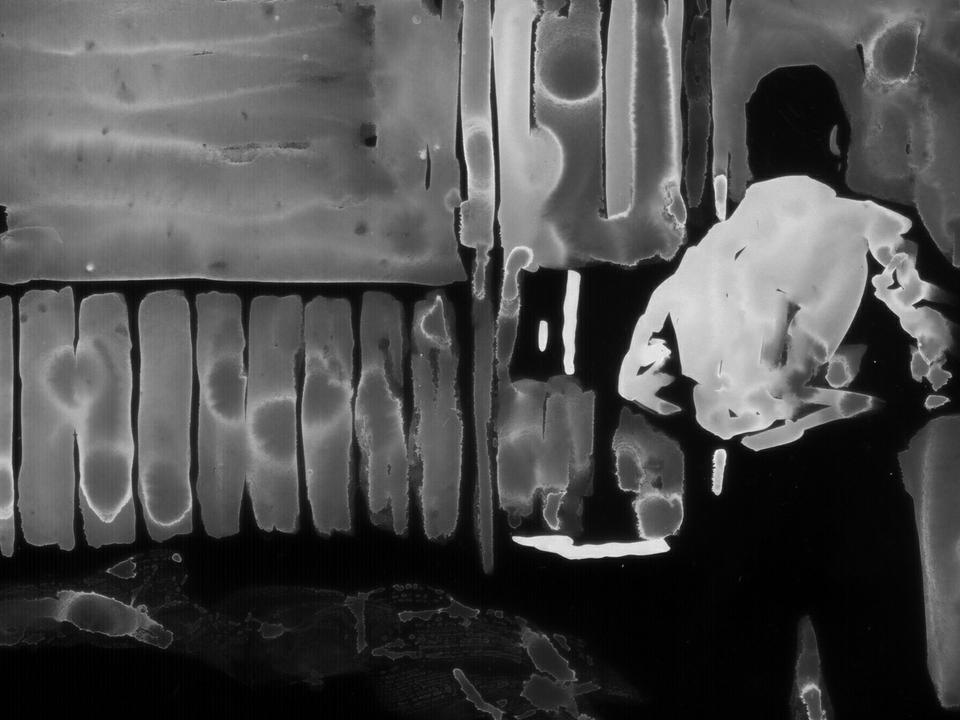
News
Pro-Palestine Encampment Represents First Major Test for Harvard President Alan Garber

News
Israeli PM Benjamin Netanyahu Condemns Antisemitism at U.S. Colleges Amid Encampment at Harvard

News
‘A Joke’: Nikole Hannah-Jones Says Harvard Should Spend More on Legacy of Slavery Initiative

News
Massachusetts ACLU Demands Harvard Reinstate PSC in Letter

News
LIVE UPDATES: Pro-Palestine Protesters Begin Encampment in Harvard Yard
Carpenter Frames Saunders’ Paint And Film

On one late-’90s night, as other Harvard undergrads partied or hunched over their textbooks, Matthew R. Saunders ’97 sat enraptured in the basement of the Carpenter Center. On the theater-sized screen before him played the work of Jack Smith, a filmmaker whose humdrum name belies his influence on artists who succeeded him, among them Andy Warhol—and Saunders.
“The most transformative thing I experienced here as a student was seeing two Jack Smith films,” said Saunders, a visiting lecturer on Visual and Environmental Studies. Now, a decade and a half later, an animated short by Saunders plays on the same screen that showed Smith’s films. The animation is part of Saunders’ new exhibit, “The movies that were secret remain secret somehow and a nation forgets its pleasures.,” which takes its title from a Smith essay.
The exhibit, which runs through November 4 in the Carpenter Center basement and Harvard Film Archive, is part of the celebration of the 50th anniversary of the Carpenter Center. But particularly, Saunders said, it is a tribute to the basement itself and to the HFA, which is housed there. “When I was a student, I spent a lot of time in the Film Archive, and it was a really important place for me,” Saunders said. “If I thought of the history of the building and [of] trying to say something about it through the eyes of someone who spent a lot of years here, that was the place I wanted to speak to.”
And speak to it he does—the exhibit is less an art show than an interaction with the space. “It’s not exactly a show, because a show would be organized more tightly,” Saunders said. Instead, the exhibit primarily features two short animations, one shown in the theater and one housed under the stairs that lead to the basement of the Carpenter Center. A display case in the basement also holds some of Saunders’ static works, and prints of his visual art have been inserted alongside informational materials about upcoming films at the Archive.
As he began to conceive the exhibit, Saunders said, he knew he did not want to organize a straightforward gallery show; instead, his first inspiration was to work with the HFA theater located in the Carpenter Center basement. “I had this idea of this empty theater with this film playing as some kind of gesture of returning my work back to some place that was meaningful to it,” Saunders said.
For Saunders, who concentrated in VES, the Carpenter Center has always had two distinct rhythms—that of the VES classes taking place above ground and that of the HFA and its film screenings in the basement. “I thought it would be interesting to treat this space as a place where [the rhythms] mix more” Saunders said. The exhibit’s central film plays from 12 p.m. to 1 p.m. every weekday in a space that doubles as an HFA theater and a lecture hall for VES classes, though at a time when no classes are held. “It’s occupying the negative space of [the VES class and HFA] program,” Saunders said.
Other elements of Saunders’ exhibit also make use of negative space—for instance, the small prints nestled among the informational blurbs and images displayed by the Film Archive. And in the animations, the foreground images, which range from abstract shapes to distinct people and objects, retain their grayscale palette while the background space alternately flashes black and white. “It’s about destabilizing,” Saunders said of the flashing. “A lot of these films are these very still images that I feel are unstable in some ways, so I wanted to introduce another vocabulary of this kind of endless motion.”
Of the static visual art featured, many works are large “photo prints” created by shining light through painted canvases to expose the photo paper. “The traditional approach is so uninteresting,” Saunders said. “The bigger photo prints, you could say that they’re hybrid objects between painting and photography.” Saunders, who said he considers himself foremost a painter, has previously experimented with other painting techniques—another work on display was made by painting both surfaces of a plastic sheet.
Though Saunders works in disparate styles and media, HFA Director Haden Guest said that Saunders’ body of work is united by his passion for film. “Matt’s work is really engaged with cinema, and a lot of his inspirations and seeds for the imagery of some of his most powerful works come from films. He’s an artist who’s really in dialogue with cinema,” Guest said.
Guest feels that the exhibit, in part inspired by Saunders’ experience at the Archive, serves also as a testament to the value of the HFA. “I think this show draws attention to…the kind of films that are being shown here,” he said. And perhaps, one quiet night, another young artist will wander into the theater to see the work of an innovative filmmaker and be indelibly inspired.
Want to keep up with breaking news? Subscribe to our email newsletter.
